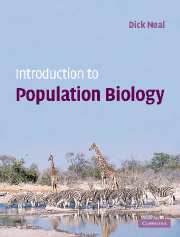Book contents
- Frontmatter
- Contents
- Preface
- Acknowledgements
- PART I Evolution by natural selection
- Chapter 1 Darwin concludes that organisms evolve
- Chapter 2 Darwin's theories of evolution
- Chapter 3 Understanding natural selection
- PART II Simple population growth models and their simulation
- PART III Population genetics and evolution
- PART IV Demography
- PART V Interactions between species, and the behaviour of individuals
- Glossary
- Solutions to problems
- References
- Index
Chapter 3 - Understanding natural selection
- Frontmatter
- Contents
- Preface
- Acknowledgements
- PART I Evolution by natural selection
- Chapter 1 Darwin concludes that organisms evolve
- Chapter 2 Darwin's theories of evolution
- Chapter 3 Understanding natural selection
- PART II Simple population growth models and their simulation
- PART III Population genetics and evolution
- PART IV Demography
- PART V Interactions between species, and the behaviour of individuals
- Glossary
- Solutions to problems
- References
- Index
Summary
The theory of natural selection is deceptively simple. We have seen in Chapter 2 that Darwin formulated the theory as a sequence of facts and logical deductions or inferences arising from these facts:
Individuals in a population vary in their characteristics, and these variations are heritable (i.e. genetically based) at least in part.
New variation is created generation after generation.
Parents produce on average more offspring than are needed to replace them, and so populations have the potential to increase exponentially. Resources are finite and so will be insufficient to sustain all offspring in the long term.
As a consequence, there will be a struggle for existence, and only a fraction (often a very small fraction) of the offspring will survive to reproduce.
Survival is not random with respect to variation, and some variations will be better able to survive and will produce more off spring than others. This results in the accumulation of favourable variations at the expense of variations that are less favoured, generation after generation. The characteristics of the population slowly change over time (i.e. evolve).
Given sufficient time, the accumulated change will be large, and over vast geological time periods could account for the production of all species from a single ancestor.
We will be examining many of these statements in more detail throughout this book. In this chapter we will amplify these six simple statements in order to discuss some of the popular misconceptions about the process of natural selection.
- Type
- Chapter
- Information
- Introduction to Population Biology , pp. 33 - 50Publisher: Cambridge University PressPrint publication year: 2003



